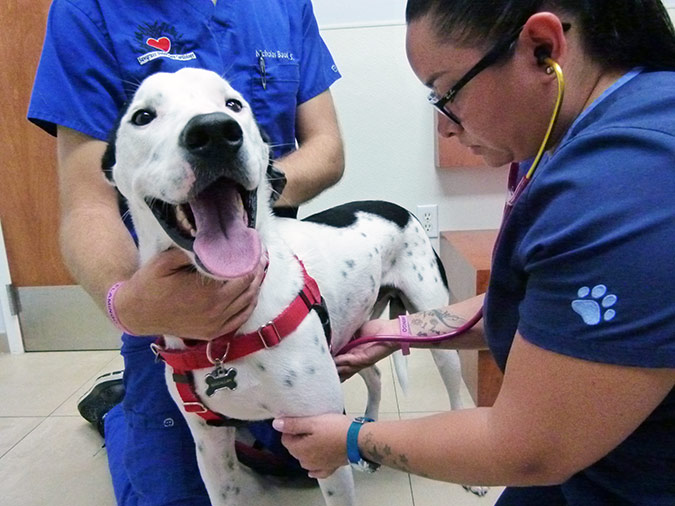The Role of Ultrasound and CT Scan in Modern Vet Practices: Insights From Experienced Professionals
In modern-day veterinary techniques, ultrasound and CT scans considerably improve diagnostic capabilities. These imaging techniques offer essential understandings right into animal health and wellness, guiding treatment choices. Experienced professionals acknowledge the distinct advantages of each method. Ultrasound provides real-time assessments, while CT scans supply intricate anatomical information. Comprehending their applications and duties elevates crucial concerns concerning their impact on patient end results and the future of veterinary diagnostics. What insights can be gained from their incorporated use?
Recognizing Ultrasound in Veterinary Medication
Ultrasound is a crucial analysis device in veterinary medication, using a non-invasive technique to imagine interior frameworks. This imaging strategy utilizes high-frequency acoustic waves to produce real-time photos of tissues and organs, enabling veterinarians to examine problems without surgical intervention. Usual applications consist of evaluating the heart, liver, kidneys, and reproductive body organs, as well as keeping an eye on pregnancies.The procedure is relatively fast and can be performed in different settings, making it an available choice for veterinarians. Unlike radiography, ultrasound provides comprehensive details about soft cells and blood circulation, which is important for accurate diagnoses.Veterinary specialists count on ultrasound to spot abnormalities such as lumps, cysts, and fluid buildup. Its ability to assist biopsies and other procedures better improves its energy in professional method. By providing a safe and reliable method to take a look at interior makeup, ultrasound has actually ended up being a cornerstone of modern-day vet diagnostics.
The Advantages of CT Scans for Animal Diagnostics
CT scans offer significant benefits in vet diagnostics by supplying enhanced precision in recognizing interior problems (Ultrasound For Dogs). As a non-invasive imaging method, they ensure the security and convenience of pets throughout exams. In addition, CT checks help with a detailed assessment of inner frameworks, allowing for more efficient therapy planning
Improved Analysis Precision
Innovations in imaging innovation have actually greatly enhanced analysis accuracy in veterinary medicine, specifically through making use of CT scans. These scans provide thorough cross-sectional photos of an animal's interior frameworks, permitting vets to recognize irregularities with accuracy. The high resolution and three-dimensional abilities of CT imaging promote the discovery of problems such as lumps, cracks, and internal blood loss that might be missed out on with standard imaging approaches. In addition, CT scans can aid in pre-surgical planning by providing a thorough view of anatomical relationships. This degree of information not only enhances the accuracy of diagnoses but likewise aids in tailoring effective treatment plans. The integration of CT technology into veterinary techniques is changing the landscape of pet health care, enhancing end results for clients.
Non-Invasive Imaging Technique
The introduction of non-invasive imaging methods has actually transformed animal diagnostics, with CT checks emerging as a prominent device in veterinary practices. These scans provide high-resolution, cross-sectional pictures of an animal's internal frameworks, enabling vets to analyze complicated conditions without the need for invasive procedures. The advantages of CT scans include their ability to spot lumps, cracks, and internal bleeding with amazing accuracy. Furthermore, they help with the evaluation of soft cells and organs, boosting analysis capacities. The speed of CT scanning enables quick decision-making, which is crucial in emergency scenarios. By reducing stress and pain for the pet, CT scans add to an extra humane method to diagnostics, ultimately boosting treatment results and progressing veterinary care.
Comprehensive Internal Analysis
An extensive interior analysis is essential for exact diagnosis and efficient therapy in veterinary medicine. CT checks offer considerable advantages hereof, offering in-depth cross-sectional pictures of a pet's internal frameworks. This innovative imaging method enhances visualization of intricate physiological areas, enabling veterinarians to recognize abnormalities such as growths, cracks, and internal bleeding with greater accuracy. Additionally, CT scans help with the evaluation of problems that might be testing to diagnose with standard approaches. The speed and precision of CT imaging additionally contribute to timely interventions, boosting person end results. As vet techniques increasingly incorporate CT modern technology, the benefits of considerable interior analyses come to be obvious, reinforcing the significance of this device in modern-day veterinary diagnostics.
Contrasting Ultrasound and CT Imaging Techniques
While both ultrasound and CT imaging offer important functions in vet diagnostics, each method supplies distinct advantages and limitations that can affect clinical decision-making. Ultrasound is especially valued for its real-time imaging capacities, permitting vets to observe dynamic physical procedures. This technique is non-invasive, portable, and does not involve ionizing radiation, making it a more secure alternative for both clinicians and pets. Nevertheless, ultrasound may have limitations in imagining certain anatomical frameworks or deep tissues.Conversely, CT imaging offers in-depth cross-sectional views of the body, enabling for accurate localization of abnormalities. It excels in evaluating complex body organs and frameworks, especially in the thorax and abdomen. CT scans need sedation or anesthetic in many situations and include direct exposure to ionizing radiation. Inevitably, the option between ultrasound and CT relies on the certain medical circumstance, the location of rate of interest, and the urgency of the diagnostic requirements.
Instance Studies: Successful Diagnoses Through Imaging
Instance studies show the significant enhancements in analysis precision accomplished via advanced imaging innovations like ultrasound and CT scans in vet methods. These innovations not just improve the detection of numerous problems yet additionally assist in prompt and efficient treatment plans. Assessing specific cases can highlight the transformative effect of these imaging strategies on vet medicine.
Analysis Accuracy Improvements

Imaging Innovation Advancements
As vet imaging technology remains to develop, its effect on analysis abilities comes to be increasingly apparent. Recent case studies highlight the successful application of advanced ultrasound and CT scan strategies in recognizing complicated conditions. As an example, additional info a veterinary facility used high-resolution CT scans to diagnose a rare type of lung cancer cells in a pet dog, which conventional imaging had missed out on. An ultrasound evaluation revealed a stomach mass in a feline, prompting prompt surgical intervention and a favorable result. These innovations not just boost diagnostic accuracy Resources yet additionally make it possible for veterinarians to devise targeted treatment plans. By leveraging cutting-edge imaging innovations, vet experts are substantially improving individual care, leading to much more efficient management of different health problems in animals.
The Duty of Imaging in Emergency Vet Treatment
Imaging plays a crucial function in emergency veterinary treatment, providing vets with vital details needed to make rapid, educated decisions. In urgent scenarios, methods like ultrasound and CT scans allow practitioners to rapidly analyze a family pet's internal frameworks, identifying essential conditions such as internal blood loss, fractures, or body organ irregularities. These imaging techniques enable real-time analyses, helping with timely interventions that can be life-saving. Ultrasound is indispensable for examining soft tissue injuries and problems like liquid accumulation, while CT scans offer thorough images of complicated physiological structures, crucial for diagnosing trauma situations. The rate and precision of these imaging methods enhance the vet's capability to design efficient treatment strategies, making certain the most effective possible end results for their people. The integration of innovative imaging modern technologies into emergency vet techniques is not just helpful but progressively required, as it improves analysis capabilities and boosts total pet treatment throughout crucial minutes.

Training and Competence in Vet Imaging
Although advanced imaging methods such as ultrasound and CT scans are necessary for effective vet treatment, the effective execution of these innovations heavily relies on the training and expertise of veterinary specialists. Efficient use imaging tools requires thorough understanding of composition, pathology, and the principles underlying each modality. Veterinary professionals should undergo specialized training to accurately interpret imaging outcomes, which is vital for detecting conditions and planning treatment.Certifications and continuing education in vet imaging improve the skills of specialists, allowing them to remain updated with technological advancements. Partnership between vets and radiologists often causes improved diagnostic accuracy, as experts can provide insights right into intricate instances. Furthermore, practical experience in handling imaging devices fosters self-confidence in its application. Ultimately, the quality of veterinary imaging services is straight associated to the level of training and expertise possessed by the experts making use of these essential analysis devices.
Future Fads in Diagnostic Imaging for Animals
With the fast advancements in modern technology, vet analysis imaging is poised for substantial development in the coming years. Emerging fads show a change in the direction of more portable and easily accessible imaging techniques, such as handheld ultrasound devices, which might improve area diagnostics. Additionally, the integration of fabricated knowledge is anticipated to reinvent picture analysis, enabling quicker and much more accurate interpretations of results.Moreover, improvements in 3D imaging techniques and calculated tomography will certainly give veterinarians with more extensive sights of pet makeup, leading to improved therapy strategies. Virtual reality innovation official source may also contribute in medical preparation and education and learning, providing vets an unique perspective on complicated cases.As telemedicine continues to expand, remote assessments promoted by diagnostic imaging will become more usual, permitting specialists to aid basic practitioners in real-time. Generally, these trends are readied to boost the efficiency and performance of veterinary treatment, inevitably enhancing pet outcomes.
Often Asked Inquiries
Exactly How Much Do Ultrasound and CT Checks Price in Veterinary Clinics?
The expenses of ultrasound and CT scans in vet facilities commonly vary from $300 to $1,500, relying on elements such as place, center kind, and particular procedures needed for the pet's diagnosis and treatment.

Exist Any Type Of Dangers Connected With Ultrasound and CT Scans for Pet Dogs?
Ultrasound and CT scans typically present very little risks to family pets. Possible issues consist of sedation reactions and direct exposure to anesthetics. Veterinarians carefully examine each instance to reduce any kind of dangers related to these analysis procedures
Just How Long Do Ultrasound and CT Treatments Generally Take?
Ultrasound treatments typically take around 30 minutes to an hour, depending upon the complexity. CT scans, being more comprehensive, usually need 30 minutes to 90 minutes, consisting of prep work and recovery time for the family pet.
Can All Veterinarians Perform Ultrasounds and CT Scans?
Not all veterinarians can carry out ultrasounds and CT scans. Specialized training and qualification are frequently called for to assure expertise in these innovative imaging methods, which may limit their schedule to veterinarians with added qualifications and resources.
What Kinds of Animals Benefit A Lot Of From These Imaging Techniques?
Particular animal species, particularly pets and cats, benefit substantially from ultrasound and CT scans. These imaging techniques enhance diagnostic precision for conditions like lumps, internal injuries, and organ irregularities, causing improved treatment outcomes and patient treatment. The high resolution and three-dimensional capacities of CT imaging facilitate the discovery of conditions such as growths, cracks, and interior bleeding that could be missed with conventional imaging methods. Case studies highlight the significant improvements in analysis precision accomplished with sophisticated imaging innovations like ultrasound and CT scans in veterinary methods. Improving diagnostic accuracy in veterinary practices has actually been considerably assisted by advancements in imaging modern technologies such as ultrasound and CT scans. Sophisticated imaging methods such as ultrasound and CT scans are important for reliable vet care, the successful application of these technologies greatly depends on the training and proficiency of veterinary professionals. Vet experts should go through specialized training to accurately analyze imaging results, which is vital for diagnosing problems and planning treatment.Certifications and proceeding education in vet imaging boost the abilities of specialists, allowing them to remain upgraded with technical advancements.
Comments on “A Beginner’s Guide to Understanding CT Scans For Dogs}”